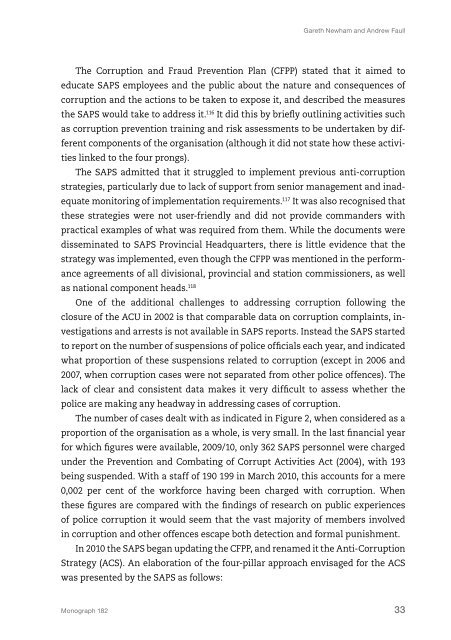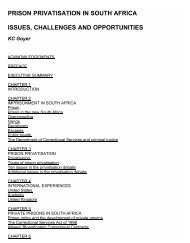Protector or predator? - Institute for Security Studies
Protector or predator? - Institute for Security Studies
Protector or predator? - Institute for Security Studies
You also want an ePaper? Increase the reach of your titles
YUMPU automatically turns print PDFs into web optimized ePapers that Google loves.
Gareth Newham and Andrew Faull<br />
The C<strong>or</strong>ruption and Fraud Prevention Plan (CFPP) stated that it aimed to<br />
educate SAPS employees and the public about the nature and consequences of<br />
c<strong>or</strong>ruption and the actions to be taken to expose it, and described the measures<br />
the SAPS would take to address it. 116 It did this by briefly outlining activities such<br />
as c<strong>or</strong>ruption prevention training and risk assessments to be undertaken by different<br />
components of the <strong>or</strong>ganisation (although it did not state how these activities<br />
linked to the four prongs).<br />
The SAPS admitted that it struggled to implement previous anti-c<strong>or</strong>ruption<br />
strategies, particularly due to lack of supp<strong>or</strong>t from seni<strong>or</strong> management and inadequate<br />
monit<strong>or</strong>ing of implementation requirements. 117 It was also recognised that<br />
these strategies were not user-friendly and did not provide commanders with<br />
practical examples of what was required from them. While the documents were<br />
disseminated to SAPS Provincial Headquarters, there is little evidence that the<br />
strategy was implemented, even though the CFPP was mentioned in the perf<strong>or</strong>mance<br />
agreements of all divisional, provincial and station commissioners, as well<br />
as national component heads. 118<br />
One of the additional challenges to addressing c<strong>or</strong>ruption following the<br />
closure of the ACU in 2002 is that comparable data on c<strong>or</strong>ruption complaints, investigations<br />
and arrests is not available in SAPS rep<strong>or</strong>ts. Instead the SAPS started<br />
to rep<strong>or</strong>t on the number of suspensions of police officials each year, and indicated<br />
what prop<strong>or</strong>tion of these suspensions related to c<strong>or</strong>ruption (except in 2006 and<br />
2007, when c<strong>or</strong>ruption cases were not separated from other police offences). The<br />
lack of clear and consistent data makes it very difficult to assess whether the<br />
police are making any headway in addressing cases of c<strong>or</strong>ruption.<br />
The number of cases dealt with as indicated in Figure 2, when considered as a<br />
prop<strong>or</strong>tion of the <strong>or</strong>ganisation as a whole, is very small. In the last financial year<br />
f<strong>or</strong> which figures were available, 2009/10, only 362 SAPS personnel were charged<br />
under the Prevention and Combating of C<strong>or</strong>rupt Activities Act (2004), with 193<br />
being suspended. With a staff of 190 199 in March 2010, this accounts f<strong>or</strong> a mere<br />
0,002 per cent of the w<strong>or</strong>kf<strong>or</strong>ce having been charged with c<strong>or</strong>ruption. When<br />
these figures are compared with the findings of research on public experiences<br />
of police c<strong>or</strong>ruption it would seem that the vast maj<strong>or</strong>ity of members involved<br />
in c<strong>or</strong>ruption and other offences escape both detection and f<strong>or</strong>mal punishment.<br />
In 2010 the SAPS began updating the CFPP, and renamed it the Anti-C<strong>or</strong>ruption<br />
Strategy (ACS). An elab<strong>or</strong>ation of the four-pillar approach envisaged f<strong>or</strong> the ACS<br />
was presented by the SAPS as follows:<br />
Monograph 182 33

















